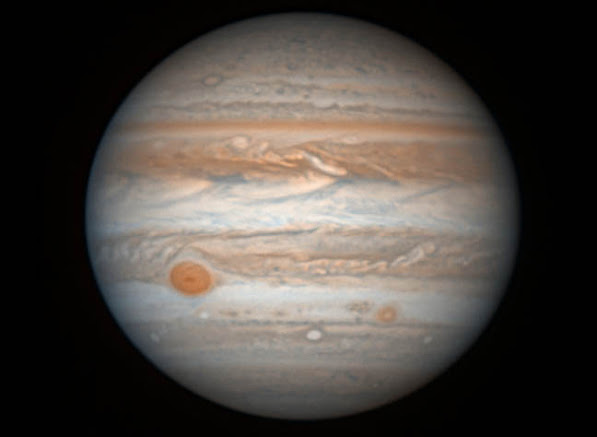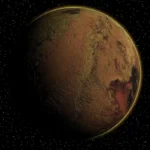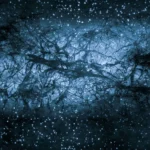
Jupiter is the biggest planet in our nearby planetary group. It is the fifth planet from the sun, delegated a gas planet and a monster simply like Uranus, Saturn and Neptune. Made up generally of hydrogen, and a littler level of helium, Jupiter does not have an extremely all around characterized surface. It was first found in the seventeenth century by telescope, yet space experts have been watching and recording Jupiter since antiquated circumstances. The planet was named after the ruler of Roman divine beings, Jupiter. There is a ring framework around Jupiter however it is black out. Around evening time, Jupiter is regularly the fourth brightest protest in the sky. The sun, the moon and Venus are brighter.
Jupiter was discovered in 1610 by Galileo Galilei. Galileo also discovered 4 of the moons of Jupiter. These moons are aptly called the Galilean moons in honor of their discoverer. The four moons discovered by Galileo were Callisto, Ganymede, Europa and Io.
The planet Jupiter is the fifth planet out from the Sun, and is two and a half times more massive than all the other planets in the solar system combined.
Jupiter is the giant of the Solar System, with a mass more than 300 times the mass of the Earth and is called after the ancient Roman sky-god, Jupiter, known to the Greeks as Zeus.
The mass of the core of Jupiter is 10 times the mass of our Earth. The layer of fluid metallic hydrogen that covers the core extends up to 90% of the diameter of the planet. Some scientists believe that the core of Jupiter is made of rocks, metals, water ice, ammonia ice and methane ice.
Jupiter is the fourth brightest object in the solar system.Only the Sun, Moon and Venus are brighter. It is one of five planets visible to the naked eye from Earth.
Jupiter takes only 9 hours and 55 minutes to spin on its axis. This means a day on Jupiter is less than 10 hours long. Its fast rotation causes the planet to be squashed, being wider at the equator than from North to South.
Jupiter is the planet with the strongest pull of gravity in the Solar System. If we were able to stand on the surface of Jupiter, we would weigh three times as much as we would weigh on Earth. The only other object in the Solar System with a stronger pull of gravity is the Sun.
Jupiter’s moon Ganymede is the largest moon in the solar system.Jupiter’s moons are some times called the Jovian satellites, the largest of these are Ganymeade, Callisto, Io and Europa. Ganymeade measures 5,268 km across, making it larger than the planet Mercury.
Jupiter is 7% wider at its equator compare to its width at the poles. This is because of its extreme spinning speed that makes the planet bulge out at its waistline.
The atmosphere of Jupiter is composed of 10.2% helium, 89.8% molecular hydrogen and trace amounts of ammonia hydrosulfide aerosols, water ice aerosols, water, ethane, hydrogen deuterite, ammonia and methane.
The core of Jupiter is massive and dense. Its composition is uncertain. The core is surrounded by a layer of helium-rich fluid metallic hydrogen and the whole thing is then wrapped up in an atmosphere that primarily consists of molecular hydrogen.
There are 63 moons in total, four of which are large enough to be easily observed with a small telescope.
The first person to discover and observe Jupiter’s moons was Galileo (1564-1642).
Jupiter orbits the Sun once every 11.8 Earth years.From our point of view on Earth, it appears to move slowly in the sky, taking months to move from one constellation to another.
Jupiter has a very strong magnetic field. This is around 14 times stronger than the magnetic field found on Earth – the largest of any planet in the solar system.
Thick, colorful clouds of deadly poisonous gases surround Jupiter. The quick spinning of the planet whips up the atmosphere, creating the bands around the planet.
The white clouds are formed by frozen ammonia crystals while the dark clouds are the results of other chemicals that are found in the darker belts.
Blue clouds can be seen at the deepest visible levels of Jupiter’s atmosphere.
The Great Red Spot is the most extraordinary feature of Jupiter. It is actually a storm akin to a hurricane on Earth. This storm has been visible for at least 300 years. There are times when the Great Red Spot completely disappears. This Great Red Spot, at the widest points, is 3 times as wide as Earth’s diameter. The edges of the spot spin around its center in a counterclockwise direction at a speed of 360 kilometers per hour or 225 miles per hour.
Interestingly, if Jupiter had managed to grab 80 times more mass than its current mass, it would actually end up being a star instead of a planet.
Jupiter’s atmosphere is very similar to that of our Sun. The atmosphere is made up to mostly helium and hydrogen.
Jupiter has colored bands. These are visible in form of light zones and dark belts. These colored bands originate because of the strong east-west winds that travel in the upper atmosphere of the planet at a speed of 640 kilometers per hour or 400 miles per hour.
Jupiter is the fastest spinning planet in Solar System. It completes one rotation around its axis in just under 10 hours.
Jupiter has a liquid metal ocean (metallic hydrogen) at its center, surrounded by thousands of kilometers of hydrogen and helium gas.
Jupiter has a big red spot known as Jupiter’s Great Red Spot.The red spot is a huge storm that has been
continuously going on Jupiter for over 350 years. Winds inside this storm reach speeds of about 435 km/h (270 mp/h).
Jupiter is so massive that its total mass is twice as much as the mass of all planets in Solar System combined together. Jupiter is capable of holding 1300 Earths in it. However, the mass of Jupiter is only 1 thousandths of the total mass of Sun.
Jupiter is the vacuum cleaner of the Solar System. It sucks in comets, asteroids and meteorites which could be on a collision course for Earth.
Eight spacecraft have visited Jupiter.Pioneer 10 and 11, Voyager 1 and 2, Galileo, Cassini, Ulysses, and New Horizons missions. The Juno mission is its way to Jupiter and will arrive in July 2016.
The first recorded sighting of Jupiter were by the ancient Babylonians in around 7th or 8th BC.
The magnetic field of Jupiter is 20,000 times stronger to that of Earth’s magnetic field.
Because of its gargantuan magnetic field, the planet is capable of trapping electronically charged particles such as electrons and other particles. These particles form a belt around the planet. The moons and the rings of Jupiter are regularly blasted with radiations.
The radiations from this belt is 1000 times stronger than the lethal dose of radiation for humans. The radiations are so intense that they even damaged the Galileo probe of NASA that was heavily shielded.
The entire magnetosphere of Jupiter (the magnetic fields and the charged particles) extend out to some 600 million miles behind the planet and some 600,000 miles to 2 million miles towards the Sun.









